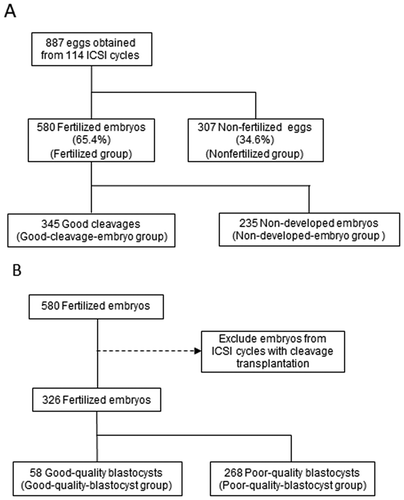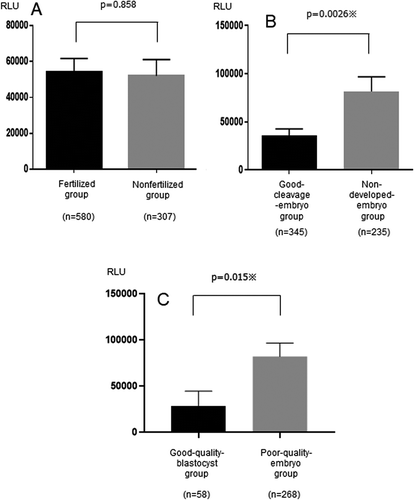Figures & data
Table 1. Patients’ characteristics and semen analyses (n = 77).
Figure 1. Experimental Design (A) Flowchart of how the eggs and embryos were divided into groups for between-group comparisons; the fertilized and nonfertilized groups and the good-cleavage-embryo and non-developed-embryo groups were compared. (B) Flowchart of how the fertilized embryos were divided to compare the good-quality-blastocyst and poor-quality-embryo groups.

Table 2. Comparison of ROS levels in semen between the fertilized and nonfertilized groups.
Table 3. Comparison of ROS levels in semen between the good-cleavage-embryo and non-developed-embryo groups.
Figure 2. Comparison of reactive oxygen species (ROS) levels (A) Comparison of reactive oxygen species (ROS) levels between the fertilized and nonfertilized eggs. The mean (± standard error) ROS levels were not significantly different between the fertilized and nonfertilized groups (P = 0.858). (B) Comparison of ROS levels between the good-cleavage-embryo and non-developed-embryo groups. The ROS level was higher in the non-developed-embryo group than in the good-cleavage-embryo group, which was statistically significant (P = 0.0026). (C) Comparison of ROS levels between the good-quality-embryo and poor-quality-embryo groups. The ROS level was lower in the good-quality-blastocyst group than in the poor-quality-embryo group, which was statistically significant (P = 0.015).

Table 4. Comparison of ROS levels in semen between the good-quality-blastocyst and poor-quality-embryo groups.
Supplemental Material
Download Zip (462.6 KB)Data availability statement
The data that support the findings of this study are available upon request from the corresponding author, TT.
